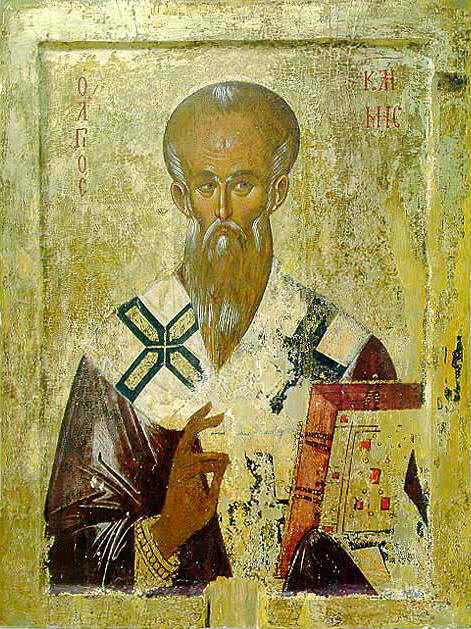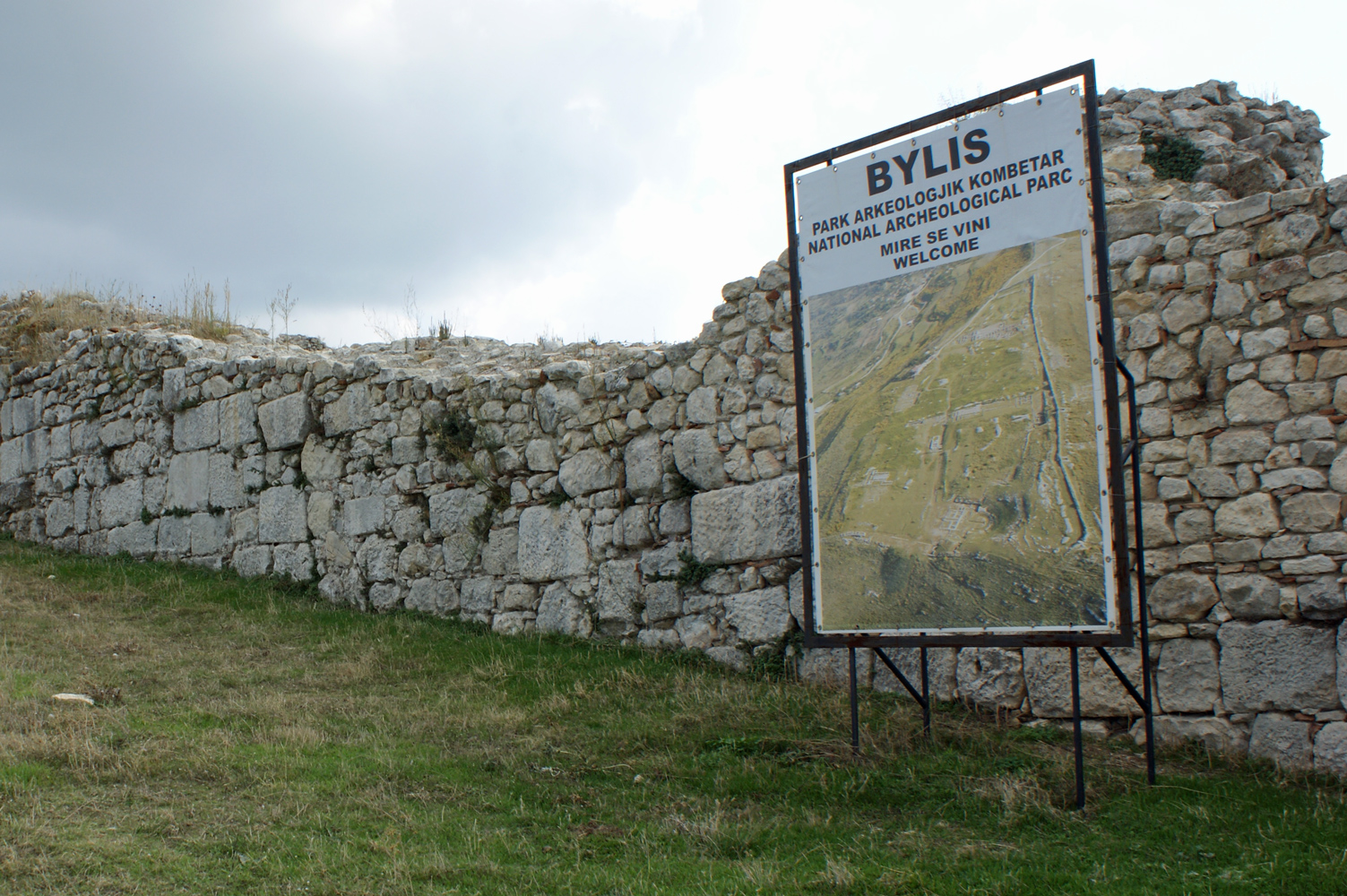|
Glavinica
Glavinica or Glavenica was a medieval town that was located in present-day southern Albania. It is mentioned in the "Short Life" of Clement of Ohrid as one of the three places of rest provided by the Bulgarian prince Boris I () to Clement. It is known that the town foll within the historical district of Kutmichevitsa, but its exact location is unknown. Some modern scholars believe that the city was located on the site of the modern town of Ballsh, where in 1918 the Austrian army discovered a column with an inscription testifying to the baptism of the Bulgarians during the reign of Prince Boris. In the "Short Life" it is mentioned that he left such monuments around Glavinica, which in the beginning of the 13th century could still be seen around Balshi. According to other assumptions, the city was located near the city of Vlora.Dimitri Obolensky, Six Byzantine Portraits. Oxford University Press Academic Monograph Reprints Series, Clarendon Press, 1988; , p. 29. Glavenitsa was the ... [...More Info...] [...Related Items...] OR: [Wikipedia] [Google] [Baidu] |
Albania
Albania ( ; sq, Shqipëri or ), or , also or . officially the Republic of Albania ( sq, Republika e Shqipërisë), is a country in Southeastern Europe. It is located on the Adriatic and Ionian Seas within the Mediterranean Sea and shares land borders with Montenegro to the northwest, Kosovo to the northeast, North Macedonia to the east and Greece to the south. Tirana is its capital and largest city, followed by Durrës, Vlorë, and Shkodër. Albania displays varied climatic, geological, hydrological, and morphological conditions, defined in an area of . It possesses significant diversity with the landscape ranging from the snow-capped mountains in the Albanian Alps as well as the Korab, Skanderbeg, Pindus and Ceraunian Mountains to the hot and sunny coasts of the Albanian Adriatic and Ionian Sea along the Mediterranean Sea. Albania has been inhabited by different civilisations over time, such as the Illyrians, Thracians, Greeks, Romans, Byzantines, Venetians, and Ot ... [...More Info...] [...Related Items...] OR: [Wikipedia] [Google] [Baidu] |
Clement Of Ohrid
Clement or Kliment of Ohrid (Bulgarian, Macedonian, srp, Климент Охридски, ''Kliment Ohridski''; grc-gre, Κλήμης τῆς Ἀχρίδας, ''Klḗmēs tē̂s Akhrídas''; sk, Kliment Ochridský; – 916) was one of the first medieval Bulgarian saints, scholar, writer, and apostle to the Slavs. He was one of the most prominent disciples of Cyril and Methodius and is often associated with the creation of the Glagolitic and Cyrillic scripts, especially their popularisation among Christianised Slavs. He was the founder of the Ohrid Literary School and is regarded as a patron of education and language by some Slavic people. He is considered to be the first bishop of the Bulgarian Orthodox Church, one of the Seven Apostles of Bulgarian Orthodox Church since the 10th century, and one of the premier saints of modern Bulgaria. The mission of Clement was the crucial factor which transformed the Slavs in then Kutmichevitsa (present-day Macedonia) into Bulgari ... [...More Info...] [...Related Items...] OR: [Wikipedia] [Google] [Baidu] |
Boris I
Boris I, also known as Boris-Mihail (Michael) and ''Bogoris'' ( cu, Борисъ А҃ / Борисъ-Михаилъ bg, Борис I / Борис-Михаил; died 2 May 907), was the ruler of the First Bulgarian Empire in 852–889. At the time of his baptism in 864, Boris was named Michael after his godfather, Emperor Michael III. The historian Steven Runciman called him one of the greatest persons in history. Despite a number of military setbacks, the reign of Boris I was marked with significant events that shaped Bulgarian and European history. With the Christianization of Bulgaria in 864 paganism (i.e. Tengrism) was abolished. A skillful diplomat, Boris I successfully exploited the conflict between the Patriarchate of Constantinople and the Papacy to secure an autocephalous Bulgarian Church, thus dealing with the nobility's concerns about Byzantine interference in Bulgaria's internal affairs. When in 885 the disciples of Saints Cyril and Methodius were banished f ... [...More Info...] [...Related Items...] OR: [Wikipedia] [Google] [Baidu] |
Kutmichevitsa
Kutmichevitsa ( bg, Кутмичевица) was an administrative region of the Bulgarian Empire during 9th-11th cent., corresponding roughly with the northwestern part of the region of Macedonia and the southern part of Albania, broadly taken to be the area included in the triangle Saloniki-Skopje- Vlora. It had an important impact on the formation, endorsement and development of the Old Church Slavonic and culture. The Debar–Velich diocese of the Bulgarian Orthodox Church was created in Kutmichevitsa whose first bishop between 886 and 893 was Clement of Ohrid, appointed by Knyaz Boris I. Borders To the north Kutmichevitsa reached the river Shkumbin and the ridge Chermenika (Çermenikë) which also divide northern from southern Albania and form the border between the Gheg and Tosk Albanian; to the east and north-east was separated from Macedonia by the Lake Ohrid and Lake Prespa; to the south and south-east bordered the historical region Epirus and to the west reached the pl ... [...More Info...] [...Related Items...] OR: [Wikipedia] [Google] [Baidu] |
Ballsh
Ballsh ( sq-definite, Ballshi) is a town and a former municipality in Fier County, southern Albania. At the 2015 local government reform it became a subdivision and the seat of the municipality Mallakastër. It was the seat of the former District of Mallakastër. The population at the 2011 census was 7,657.2011 census results Name It was centre of Malkasra (Turkish of "") kaza in in Yanya Vilayet during Ottoman rule between 1670 and 1912. ...[...More Info...] [...Related Items...] OR: [Wikipedia] [Google] [Baidu] |
Balshi Inscription
The Ballshi inscription is an epigraph from the time of the Bulgarian Prince (''Knyaz'') Boris I (852–889) testifying to the christianization of Bulgaria. The inscription was unearthed near Ballshi, Albania, in 1918. The Medieval Greek–language Bulgarian inscription covers the upper part of a marble column which also features, in its bottom part, the later Latin epitaph of Norman commander Robert de Montfort who died in 1108, with a cross in the middle of the column. The column was discovered by Austro-Hungarian soldiers during World War I 25 kilometres southwest of the Albanian town of Berat, near Ballshi, among the ruins of a monastery. The Ballshi inscription is a key domestic source giving important information about the Christianization of the Bulgarians and the location of the southwestern border of the First Bulgarian Empire and the region of Kutmichevitsa during the rule of Boris. Saint Clement of Ohrid's concise biography by Demetrios Chomatenos, ea ... [...More Info...] [...Related Items...] OR: [Wikipedia] [Google] [Baidu] |
Ohrid Archbishopric
The Archbishopric of Ohrid, also known as the Bulgarian Archbishopric of Ohrid *T. Kamusella in The Politics of Language and Nationalism in Modern Central Europe, Springer, 2008, p. 276 *Aisling Lyon, Decentralisation and the Management of Ethnic Conflict: Lessons from the Republic of Macedonia, Routledge, 2015, p. 24 *R. Fraser, M. Hammond ed. Books Without Borders, Volume 1: The Cross-National Dimension in Print Culture, Springer, 2008, p. 41 *H. Cox, D. Hupchick, The Palgrave Concise Historical Atlas of Eastern Europe, Springer, 2016p. 67 *J. Rgen Nielsen, Jørgen S. Nielsen ed. Religion, Ethnicity and Contested Nationhood in the Former Ottoman Space, Brill, 2011,p. 234 *John Phillips, Macedonia: Warlords and Rebels in the Balkans, I.B.Tauris, 2004, p. 19 *Frederick F. Anscombe, State, Faith, and Nation in Ottoman and Post-Ottoman Lands, Cambridge University Press, 2014,p. 151 *D. Hupchick, The Balkans: From Constantinople to Communism, Springer, 2002, p. 67 *Chris Kostov, Cont ... [...More Info...] [...Related Items...] OR: [Wikipedia] [Google] [Baidu] |
Kaninë
Kaninë is a settlement in the Vlorë County, southwestern Albania. At the 2015 local government reform it became part of the municipality Vlorë. It is home to the Kaninë Castle. Name The name of the fortified settlement of Kanina was attested for the first time at the beginning of the 11th century AD in Byzantine Greek as (in plural form). The toponym is significant for the history of the Albanian language since ''Kanina'' represents a toponym that shows no sign of the dialect phenomenon of rhotacism, which is explained by the fact that the settlement was recorded with the name ''Kanina'' in a period during which rhotacism in Albanian was no longer active for some time. On the other hand the name of nearby ''Vlorë'', attested earlier, was subject to the Albanian rhotacism. History The settlement of Kaninë developed below a hilltop Kaninë Castle which overlooks the village. The first phase of the fort dates to the late 4th/early 3rd century BCE and is linked to the developmen ... [...More Info...] [...Related Items...] OR: [Wikipedia] [Google] [Baidu] |
First Bulgarian Empire
The First Bulgarian Empire ( cu, блъгарьско цѣсарьствиѥ, blagarysko tsesarystviye; bg, Първо българско царство) was a medieval Bulgar- Slavic and later Bulgarian state that existed in Southeastern Europe between the 7th and 11th centuries AD. It was founded in 680–681 after part of the Bulgars, led by Asparuh, moved south to the northeastern Balkans. There they secured Byzantine recognition of their right to settle south of the Danube by defeatingpossibly with the help of local South Slavic tribesthe Byzantine army led by Constantine IV. During the 9th and 10th century, Bulgaria at the height of its power spread from the Danube Bend to the Black Sea and from the Dnieper River to the Adriatic Sea and became an important power in the region competing with the Byzantine Empire. It became the foremost cultural and spiritual centre of south Slavic Europe throughout most of the Middle Ages. As the state solidified its position in the Balka ... [...More Info...] [...Related Items...] OR: [Wikipedia] [Google] [Baidu] |
Medieval Albania
When the Roman Empire divided into east and west in 395, the territories of modern Albania became a part of the Byzantine Empire. At the end of the 12th century, the Principality of Arbanon was formed which lasted until mid 13th century, after its dissolution it was followed with the creation of the Albanian Kingdom after an alliance between the Albanian noblemen and Angevin dynasty. After a war against the Byzantine empire led the kingdom occasionally decrease in size until the Angevins eventually lost their rule in Albania and led the territory ruled by several different Albanian chieftains until the mid 14th century which for a short period of time were conquered by the short-lived empire of Serbia. After its fall in 1355 several chieftains regained their rule and significantly expanded until the arrival of the Ottomans after the Battle of Savra. After the Battle of Savra in 1385 most of local chieftains became Ottoman vassals. In 1415–1417 most of the central and south ... [...More Info...] [...Related Items...] OR: [Wikipedia] [Google] [Baidu] |
Populated Places Of The Byzantine Empire
Population typically refers to the number of people in a single area, whether it be a city or town, region, country, continent, or the world. Governments typically quantify the size of the resident population within their jurisdiction using a census, a process of collecting, analysing, compiling, and publishing data regarding a population. Perspectives of various disciplines Social sciences In sociology and population geography, population refers to a group of human beings with some predefined criterion in common, such as location, race, ethnicity, nationality, or religion. Demography is a social science which entails the statistical study of populations. Ecology In ecology, a population is a group of organisms of the same species who inhabit the same particular geographical area and are capable of interbreeding. The area of a sexual population is the area where inter-breeding is possible between any pair within the area and more probable than cross-breeding with ind ... [...More Info...] [...Related Items...] OR: [Wikipedia] [Google] [Baidu] |





.jpg)

